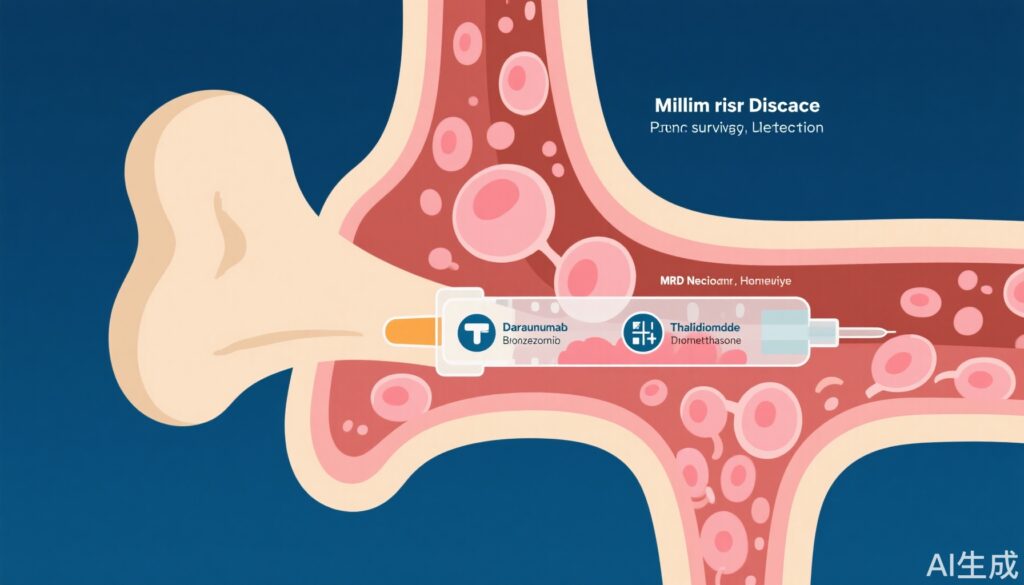Highlights
- Daratumumab plus VTd (D-VTd) induction/consolidation and daratumumab maintenance consistently achieve the highest rates of minimal residual disease (MRD) negativity and progression-free survival (PFS) in newly diagnosed, transplant-eligible multiple myeloma.
- MRD negativity rates are improved at both 10-5 and 10-6 levels, regardless of cytogenetic risk or postinduction status, with daratumumab-based regimens.
- These benefits are maintained with a median follow-up of over 80 months, underscoring the long-term durability of deep responses.
- Daratumumab maintenance offers significant PFS advantages over observation, independent of prior induction/consolidation choice or MRD status post-consolidation.
Study Background and Disease Burden
Multiple myeloma (MM) remains an incurable hematologic malignancy with high disease burden, marked by cycles of remission and relapse. Despite advances in therapy, achieving deep and durable responses is clinically challenging, especially in transplant-eligible patients. Minimal residual disease (MRD) negativity—defined as the absence of detectable malignant plasma cells at sensitivities of 10-5 or 10-6—has emerged as a robust prognostic marker, correlating with improved survival. The CASSIOPEIA study addressed the unmet need for regimens capable of maximizing both depth and durability of response in newly diagnosed, transplant-eligible patients.
Study Design
CASSIOPEIA (NCT02541383) is a two-part, randomized, phase 3 trial enrolling transplant-eligible, newly diagnosed multiple myeloma patients across multiple European centers. Participants were randomized 1:1 to receive either:
- Daratumumab plus bortezomib, thalidomide, and dexamethasone (D-VTd) induction and consolidation, or
- VTd alone (bortezomib, thalidomide, dexamethasone).
Following high-dose therapy and autologous stem cell transplantation, patients showing at least partial response were rerandomized to receive either daratumumab maintenance or observation for up to 2 years. MRD status was centrally assessed at predefined time points (after induction, after consolidation, and during maintenance/observation) using high-sensitivity flow cytometry (10-5 and 10-6 thresholds). The primary endpoints were MRD negativity rates and progression-free survival (PFS); secondary endpoints included MRD kinetics, durability, and outcomes stratified by cytogenetic risk and revised International Staging System (R-ISS) score.
Key Findings
MRD Negativity Rates
D-VTd improved MRD negativity rates after both induction (34.6% vs 23.1% for VTd; 10-5) and consolidation (63.7% vs 43.7%). Notably, daratumumab maintenance further improved landmark, cumulative, and sustained MRD negativity rates, regardless of prior induction regimen or cytogenetic risk:
- D-VTd/daratumumab vs D-VTd/observation: 10-5 (77.3% vs 70.7%), 10-6 (60.7% vs 52.0%)
- VTd/daratumumab vs VTd/observation: 10-5 (70.9% vs 51.2%), 10-6 (48.4% vs 30.7%)
Improvements in MRD negativity were consistent across subgroups defined by cytogenetic abnormalities or R-ISS score.
Progression-Free Survival (PFS)
D-VTd induction/consolidation resulted in superior PFS compared to VTd alone, regardless of postinduction MRD status. Daratumumab maintenance also conferred PFS benefit versus observation, irrespective of the induction/consolidation strategy or postconsolidation MRD status. The combination of D-VTd induction/consolidation followed by daratumumab maintenance produced the highest landmark, cumulative, and sustained MRD negativity rates, translating to the most favorable long-term PFS outcomes.
Durability and Depth of Response
After a median follow-up of 80.1 months, patients receiving D-VTd induction/consolidation and daratumumab maintenance demonstrated the deepest, most durable MRD negativity and the lowest rates of disease progression. The clinical benefit was observed at both MRD sensitivity thresholds and in high-risk subgroups, reinforcing the robustness of the findings.
Safety and Tolerability
Safety results from prior CASSIOPEIA analyses indicated no unexpected toxicity with daratumumab-based regimens. The addition of daratumumab did not significantly increase the incidence of grade 3/4 adverse events compared to VTd alone. The risk-benefit profile remains favorable, supporting adoption in eligible patients.
Expert Commentary
The CASSIOPEIA trial provides unequivocal evidence that the incorporation of daratumumab into VTd induction/consolidation and as maintenance therapy sets a new benchmark for depth, durability, and clinical significance of response in newly diagnosed, transplant-eligible multiple myeloma. The achievement of MRD negativity at high sensitivity, particularly when sustained, is now a validated surrogate for prolonged PFS and potentially overall survival. Importantly, these benefits extend to patients with high-risk cytogenetics and advanced disease stage, traditionally considered hard to treat.
Despite these advances, questions remain regarding optimal MRD assessment intervals, the role of MRD-guided therapy discontinuation, and cost-effectiveness in different healthcare settings. Nonetheless, these long-term data support routine MRD monitoring and daratumumab-based strategies as standard of care in this population.
Conclusion
Long-term follow-up from CASSIOPEIA confirms that D-VTd induction/consolidation followed by daratumumab maintenance provides the deepest and most durable MRD negativity, translating into superior PFS for transplant-eligible, newly diagnosed multiple myeloma. These results advocate for the integration of MRD-driven endpoints in both clinical trial design and routine practice, and firmly establish daratumumab-based regimens as the frontline standard for this patient population.
References
Corre J, Vincent L, Moreau P, Hebraud B, Hulin C, Béné MC, Broijl A, Caillot D, Delforge M, Dejoie T, Facon T, Lambert J, Leleu X, Macro M, Perrot A, Zweegman S, Filleron T, Cabarrou B, van de Donk NWCJ, Mahéo S, Hua W, Wang J, Krevvata M, Vanquickelberghe V, de Boer C, Tuozzo A, Borgsten F, Rowe M, Carson R, Wuilleme S, Sonneveld P. Daratumumab-bortezomib-thalidomide-dexamethasone for newly diagnosed myeloma: CASSIOPEIA minimal residual disease results. Blood. 2025 Aug 7;146(6):679-692. doi: 10.1182/blood.2024027620. PMID: 40127397.



